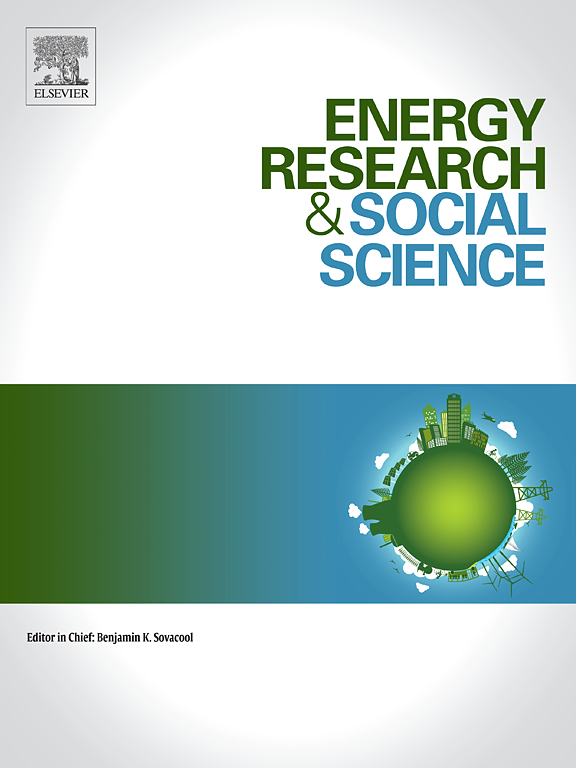The limits of energy conservation: Why doubling current energy efficiency progress is no easy feat
IF 7.4
2区 经济学
Q1 ENVIRONMENTAL STUDIES
引用次数: 0
Abstract
Energy efficiency is central to achieving global decarbonization objectives. The COP28 agreement calls for doubling the average annual rate of energy efficiency improvements from 2 % to 4 % annually by 2030. To explore the feasibility of this target, we first apply a Kaya-identity decomposition—at both global and regional levels—to separate activity, structural, and intensity effects, distinguishing conversion from final-energy efficiency at the point of use. The regional breakdown exposes marked heterogeneity across industrialized, emerging, and least-developed economies. We then used a complementary forecasting framework—autoregressive integrated moving-average, exponential smoothing, and prophet models—that provides complementary outlooks. While historical gains have moderated energy demand, sustained improvements beyond 2 % per year have been rare and typically driven by economic contractions rather than structural shifts. Our baseline projections reach only 1.9 % per year under current policies, leaving a persistent annual shortfall of 2–3 percentage points and a cumulative gap of ≈19 % by 2030. We interpret these findings through the multi-level perspective: (i) at the landscape level, international commitments outpace many national capabilities; (ii) at the regime level, established rules, limited finance, and “low-hanging-fruit” depletion slow further progress; and (iii) at the niche level, innovations such as widespread electrification, smart demand response, and low-cost retrofits can accelerate savings but remain unevenly accessible. Meeting the 4 % target will require binding performance standards, sizable financial incentives, accelerated technology diffusion, and explicit safeguards for affordability and equity.
节约能源的限制:为什么将目前的能源效率提高一倍并非易事
能源效率是实现全球脱碳目标的核心。COP28协议要求到2030年将能源效率的平均年增长率从2%提高到4%。为了探索这一目标的可行性,我们首先在全球和区域层面应用kaya身份分解来分离活动,结构和强度影响,在使用点将转换与最终能源效率区分开来。区域划分暴露了工业化经济体、新兴经济体和最不发达经济体之间的显著异质性。然后,我们使用了一个互补的预测框架——自回归集成移动平均、指数平滑和先知模型——提供了互补的前景。虽然历史上的增长减缓了能源需求,但每年超过2%的持续增长很少,而且通常是由经济收缩而不是结构转变驱动的。在现行政策下,我们的基线预测仅为每年1.9%,到2030年,每年的差距将持续2-3个百分点,累计差距约为19%。我们通过多层次的视角来解释这些发现:(i)在景观层面,国际承诺超过了许多国家的能力;在制度一级,既定的规则、有限的资金和“唾手可得的果实”的枯竭阻碍了进一步的进展;(iii)在利基层面,广泛的电气化、智能需求响应和低成本改造等创新可以加速节约,但仍然不均衡。要达到4%的目标,需要有约束力的绩效标准、可观的财政激励、加速技术扩散,以及对可负担性和公平性的明确保障。
本文章由计算机程序翻译,如有差异,请以英文原文为准。
求助全文
约1分钟内获得全文
求助全文
来源期刊

Energy Research & Social Science
ENVIRONMENTAL STUDIES-
CiteScore
14.00
自引率
16.40%
发文量
441
审稿时长
55 days
期刊介绍:
Energy Research & Social Science (ERSS) is a peer-reviewed international journal that publishes original research and review articles examining the relationship between energy systems and society. ERSS covers a range of topics revolving around the intersection of energy technologies, fuels, and resources on one side and social processes and influences - including communities of energy users, people affected by energy production, social institutions, customs, traditions, behaviors, and policies - on the other. Put another way, ERSS investigates the social system surrounding energy technology and hardware. ERSS is relevant for energy practitioners, researchers interested in the social aspects of energy production or use, and policymakers.
Energy Research & Social Science (ERSS) provides an interdisciplinary forum to discuss how social and technical issues related to energy production and consumption interact. Energy production, distribution, and consumption all have both technical and human components, and the latter involves the human causes and consequences of energy-related activities and processes as well as social structures that shape how people interact with energy systems. Energy analysis, therefore, needs to look beyond the dimensions of technology and economics to include these social and human elements.
 求助内容:
求助内容: 应助结果提醒方式:
应助结果提醒方式:


